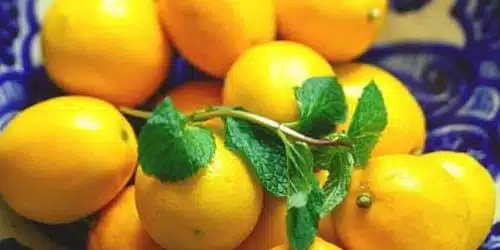
Happy Accident Soup began as a Claudia Roden recipe from The New Book of Middle Eastern Food. My market has recently begun carrying high-quality, locally sourced lamb, and I’d purchased a pound of lean cubes labeled “kebab cut”, which were a dollar cheaper than the stew cut.
Having no way of preparing kebabs—that is, no grill—I began paging through my Claudia Roden cookbooks. Food writer and Food52 blogger Amanda Hesser calls Claudia Roden one of the “Mistresses of the Mediterranean”. Who better to consult?
I landed on Lamb Tagine with Peas, Preserved Lemon, and Olives. Unlike many tagines, this one is straight-up savory: no fruit, no sweet spices. Okay, there is a teaspoon of ginger in there, but we’re hardly talking handfuls of dates or spoonfuls of honey.
The recipe calls for leg or shoulder of lamb, vegetable oil, onion, salt, pepper, the aforementioned ginger, an optional pinch of hot red pepper flakes. (Not optional in my book: my pinch verged on the old English measure “a walnut”.). It also includes saffron, an expensive spice I’m not fond of and don’t use, fresh or frozen peas (I used organic frozen), two tomatoes, which I replaced at this time of year with some frozen oven roasted tomatoes (supplies are running low, as I can never oven dry and freeze enough), one preserved lemon (more on this below), and green olives.
The tagine couldn’t be simpler. You plunk everything save the peas, tomatoes, lemon, and olives into a pot, cover everything with water, and simmer the whole shebang stovetop until the meat is tender. Depending on the cut you’re using, this takes anywhere from one-two and one-half hours. nce the meat is tender, add the last four ingredients and cook a few minutes more, until the peas are tender, or, as Roden writes: “until the sauce is reduced.”
You won’t really have a sauce. You’ll have what appears to be an alarmingly watery mess, until you stick a spoon in and have a taste. The “sauce”, all that water you poured in a couple hours ago, has sucked up the flavors from the meat, spices, lemon, tomatoes, and olives, melding it into the most delectable broth.
At the beginning of November, with cold and flu season hard upon us, not to mention the hell of the holidays, you would be insane to reduce this ambrosial substance. Ladle it off into a refrigerator or freezer-safe container. If your lamb is a fatty cut, allow it to cool, then skim the fat with a spoon or blot it carefully with paper towels. Don’t worry if a few peas snuck in there. That’s good.
If you plan to eat it this within three days, refrigerate it. Otherwise, stick in the freezer and wait for that cold or flu you know will come at the worst possible time. You’ll be happy you did. Provided you used a lean cut, or skimmed well, this usually rather indigestible meat provides a soothing, nourishing, head-clearing repast. When that cold or flu tries to get you—most likely the day you need to fly home for the holidays—get your broth from the freezer, defrost, heat, eat. You will at least make it to the airport bar.
As for the tagine itself, it’s a wonderful interplay of flavors Roden suggests serving with bread or couscous, all I can say is bring your appetite and self-restraint in equal measure. You’ll need both. And how often do you get two separate dishes from one easy recipe? About as often as you get two excellent benefits from one excellent thing, whatever that thing may be. You get my drift.
* * *
A note on preserved lemons: You can purchase preserved lemons online and in Middle Eastern markets, but they are ridiculously expensive. If you can slice an onion, you can make preserved lemons. All you need is lemons, salt and a jar. Recipes abound online, or feel free to email me at Dianesleach@gmail.com.
